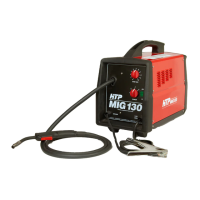25
Failure to keep the nozzle adequately cleaned
can result in the following problems:
A SHORTED nozzle results when spatter
buildup bridges the insulation in the nozzle,
allowing welding current to flow through it
as well as the contact tip. When shorted, a
nozzle will steal welding current from the
wire whenever it contacts the grounded work
piece. This causes erratic welds and reduced
penetration. In addition, a shorted nozzle
overheats the end of the gun, which can
DAMAGE the front-end of the gun.
A RESTRICTED nozzle is created when
enough slag builds up in the nozzle to affect
the direction, concentration, and/or rate of
the shielding gas flow. This problem can
cause porous, brittle welds and reduce pene-
tration.
TESTING FOR A SHORTED NOZZLE
Arcing between the nozzle and the work
piece ALWAYS means the nozzle is shorted,
but this can be hard to detect through the
lens of a welding helmet. The following test-
ing method is another way to tell if a nozzle is
shorted.
With the welder unplugged from the ac
power source, touch the probes of an ohm-
meter or continuity tester to the end of the
contact tip and the outside of the nozzle. If
there is any continuity at all, the nozzle IS
shorted. Clean or replace as needed.
REPLACE A GUN LINER
When installing a new gun liner, care must be
taken not to kink or otherwise damage the
gun liner. See Figure 20 for the drive assem-
bly and Figure 21 for the gun assembly.
1. Turn OFF welder POWER SWITCH and
unplug welder from power supply.
2. Open the welder side panel.
3. Loosen the tension arm and lift it up off
the drive roller.
4. Turn the wire spool counter-clockwise (be
sure to hold onto the wire itself while
turning the spool or the wire will unspool
itself when it becomes free of the gun
liner), and remove wire from gun
assembly.
5. Lay gun cable and gun handle straight
out in front of unit.
6. Remove gun liner holding clamp by
removing two self tapping screws and
two screws M4.
7. Take gun handle halves apart by remov-
ing five phillips head screws.
8. Remove gas hose from fast coupler fitting
on Gas Valve. Depress lip on fast coupler
fitting back towards fitting and pull gas
hose out.
9. Remove Fast Coupler Fitting from Gas
Valve using a 9 millimeter wrench.
10. Firmly hold the brass fitting on the end of
the gun liner with a wrench and rotate
Gas Valve counterclockwise to unscrew
fitting.
Note: Rotate Gas Valve – Do not rotate
brass fitting or gun liner twist inside gun
cable and may cause damage to gun
cable.
11. The Live Wire Terminal is held in place on
the Gas Valve by the brass fitting on the
end of the gun liner. When the brass fit-
ting is removed , slide the Live Wire
Terminal off of the brass fitting.
12. Firmly grip the gun cable and pull the
gun liner all the way out.
13. Install the new gun liner into gun cable,
starting from the end where the welding
gun will be mounted, and feeding the
liner all the way through the gun cable to
the wire feed roller.
Note: It may be helpful to apply a small
amount of liquid soap to the end of the
gun liner to decrease resistance during
installation process.
14. Slide the eyelet of the Live Wire Terminal
onto the threaded end of the gun liner
brass fitting.
15. Firmly hold the brass fitting on the end of
the gun liner with a wrench and rotate
Gas Valve clockwise to screw it onto fit-
ting.
Note: Rotate Gas Valve – Do not rotate
brass fitting or gun liner will twist inside
gun cable and may cause damage to gun
cable.
16. Return all components to the handle cas-
ing and realign them as they were origi-
nally.
17. With both halves of the handle case in
place, tighten the five phillips head
screws.

